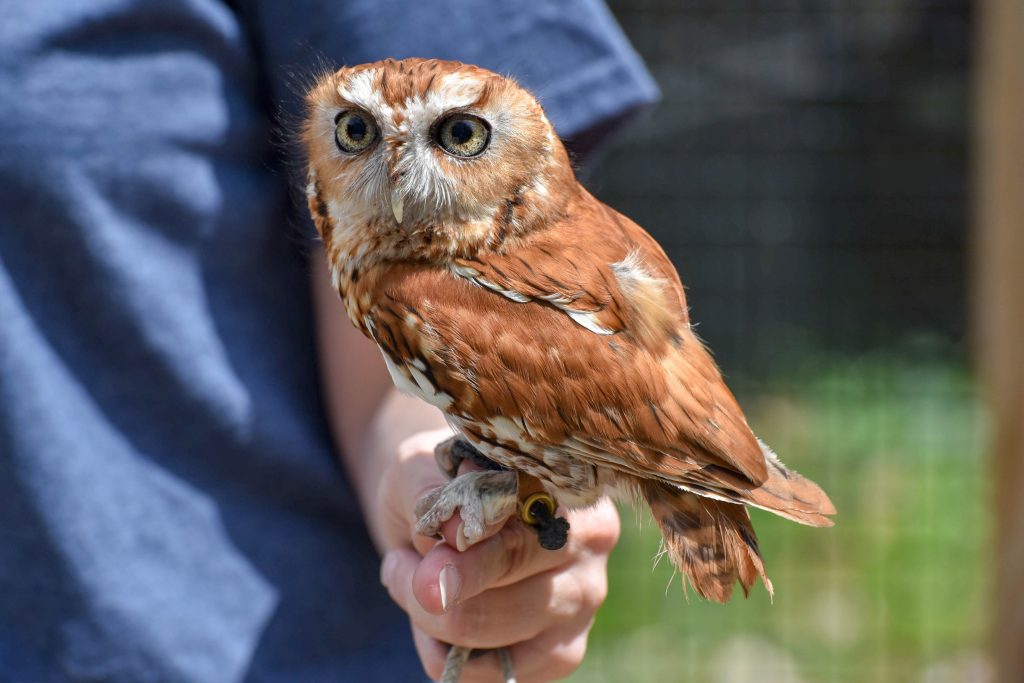Overview
“Where I live”
Eastern screech owls are distributed widely from southern Canada, across the entire eastern United States, and into northern Mexico. They are found in almost all types of woodland habitat, including forest, river valley, swamp, and urban and suburban parks and gardens.
The Maryland Zoo in Baltimore features an eastern screech owl among its Animal Ambassadors that are introduced to audiences in education programs on and off grounds.
“How I live there”
These small owls are opportunistic feeders that survive well in many different places so long as there are trees or some equivalent available. They nest and take shelter in tree cavities and perch in trees to watch for prey.
Eastern screech owls are sit-and-wait hunters that swoop down silently on their next meal from low-lying branches. They usually hunt in the dim light of dusk and dawn or at night. They eat many kinds of prey, ranging from insects and earthworms to songbirds and small rodents. After eating, screech owls (like other owls) expel small pellets of indigestible prey parts: bones, fur, feathers, and even teeth. The average screech owl regurgitates two to four pellets per day.
“Making my mark”
Eastern screech owls do indeed screech but are more readily recognized for their trilling and whinnying calls. This bird’s most common call is a hushed trill that lasts two to three seconds. The courting call is more of a whinny. When guarding young in the nest, females may bark or hoot. Baby screech owls peep during their first few weeks and start to chatter and hum as they get older and bigger. When begging for food, fledglings – juveniles that have left the nest – screech.
Raising Young
Eastern screech owls court and breed in late winter and early spring. In order to attract a female, a male eastern screech owl performs a unique courtship “dance.” He flies from branch to branch, slowly approaching his prospective mate, calling all the while. Once near enough, he begins to bob and swivel his head, bob his body, and wink at her slowly with one eye. If she is adequately impressed and accepts him, she will move close, touch his bill, and the two will begin to preen each other. Their courtship is then complete. Once paired, eastern screech owls are generally monogamous and mate for life.
Pairs nest in tree hollows or cavities, and are also fairly accepting of nest boxes. Females lay clutches of two to six eggs in early spring and incubate the eggs for about 26 days. After hatching, chicks are covered in white down and their eyes are sealed shut. The female will brood them (i.e. keep them safe and warm) while the male provides food. The female will tear his offerings into small pieces that the chicks can digest. Chicks will fledge – i.e. leave the nest and start to fly – after about four weeks, but will remain dependent on their parents for food for another five to six weeks.
“What eats me”
Many larger owls hunt eastern screech owls, including great horned owls and barred owls. Predators from the ground include mink, weasel, raccoon, skunk, and some snakes. A screech owl is well camouflaged against the backdrop of a tree and, when threatened, will press its wings close to its body and sit upright to resemble the stub of a branch. If camouflage fails, a screech owl’s next best defense is flight.
Conservation
The eastern screech owl is widespread and common throughout its range. It is listed as a species of least concern by the IUCN, the world’s leading conservation organization.
Taxonomy
- Kingdom: Animalia
- Phylum: Chordata
- Subphylum: Vertebrata
- Class: Aves
- Order: Strigiformes
- Family: Strigidae
- Genera: Megascops
- Species: asio
What is an Animal Ambassador?
The Maryland Zoo refers to its special collection of education program animals as “Animal Ambassadors.” The Zoo currently cares for more than 60 Animal Ambassadors, representing more than 40 species, both native and exotic. These animals are managed separately from the rest of the Zoo’s collection and cannot be seen on exhibit at the Zoo. However, many can be seen up close and personal on a rotating basis at Creature Encounters, the Zoo’s outdoor education center; at camp and school programs at the Zoo; as featured participants in community-based Outreach programs; and at special events on and off Zoo grounds.
Animal Ambassadors spend countless hours working with their human handlers, developing bonds of trust and communication that will allow them to appear in front of audiences large and small. They are not show animals. They behave naturally, focusing audiences’ attention on their natural behaviors and adaptations and giving living, breathing meaning to concepts and topics that students may be studying.
Animal Ambassadors travel all over the state of Maryland and beyond, and many also make local and national media appearances, educating about wildlife while representing the Zoo and its commitments to animal welfare and conservation.
What is The Animal Embassy?
The Animal Embassy at The Maryland Zoo is an off-exhibit area that is not open to the public. It is where the Zoo’s “Animal Ambassadors,” or education program animals, live. The Embassy is home to more than 60 individual animals representing more than 40 different species. It is staffed by its own dedicated group of keepers and volunteers and has both indoor and outdoor living space for the animals.


